Mensuralism as a commonality with Eastern Chant practice?
-
I have recently been exposed to proportional rhythm in Gregorian Chant (from this very forum), and today found the following recording that piqued my interest regarding this subject.
https://en.wikipedia.org/wiki/File:Aboun.ogg
It seems like this rendition of the Lord's Prayer in Syriac sounds very much like a mensural interpretation, with long and short notes and a common beat. Perhaps this is a further indicator that mensuralism is a more accurate interpretation of the ancient manner of singing the Chant repertoire in the West. It would make sense, since it seems obvious that the Eastern and Western forms of chant spring from the same well of musical genius and practice.
Thoughts? -
If Gregorian chant had truly had only nuances of duration, then it had to assume a completely isolated position. Something like this was and is namely unknown to the vocal monophonies of other Christian churches: Byzantine, Greek, Syriac, Coptic, etc. (Jan van Biezen, "The Rhythm of Gregorian Chant")Cardine argued that long and short notes are not in a strict proportion of time values with respect to each other, but rather degrees of nuance bound to the natural speech rhythm of the syllables. This opinion, which is still fundamentally free-rhythm, has since been adopted by many scholars. Jan van Biezen has proposed an alternative view that harmonizes both the testimonies of medieval musicians and the paleographical shapes of the neumes with a historical perspective enlightened by experience of church music through time in both the West and the East. The resulting rendition of the chant is essentially metrical. Chief among the discoveries is that of an underlying tactus, or beat, in the chant. This feature naturally brings Gregorian chant into historical and musical consistency with chant systems of other ancient churches such as the Greek and the Coptic. (Kevin M. Rooney, translator's preface)
-
Does somebody have a PDF of the Jan van Biezen article?
Tbh I still don't have a good overview on the different schools and development. Any recommondations on a book that provides a fair and neutral overview without taking too much of a position? -
The English translation is copyright, but a PDF of the Dutch original is available here:
http://www.janvanbiezen.nl/gregoriaans.pdf
Rayburn's Gregorian Chant: A History of the Controversy Concerning Its Rhythm is a fine overview of the different rhythmic schools:
https://drive.google.com/open?id=1-3pegNT_fp4H9XTJhDeRFte-gHgowRw0&authuser=2239545%40gmail.com&usp=drive_fs
In his Gregorian Chant, Willi Apel devoted seven pages at the end of chapter 2 to "The Problem of Rhythm," but be aware that it was written before the works of Vollaerts and Murray were published:
https://www.examenapium.it/cs/biblio/Apel1958.pdf#page=76
Jeannin was also a serious scholar of Eastern chant, having published works on Syrian and Chaldean chant.
I have several years of personal experience with the chant of the Melkite and Maronite churches, and a little familiarity with the Greek, Russian, and Ukrainian traditions. It was so self evident that none of those churches uses anything remotely resembling the "nuanced" interpretations of the Solesmes or "semiological" schools of chant interpretation that I never bothered to write about it at length. As far as I can tell, the nuance theory of chant rhythm is an entirely Western phenomenon with no counterpart anywhere in the Christian East.Thanked by 1Charles_Weaver -
I second Patrick's recommendation of Rayburn, but be aware that Rayburn is by no means "neutral" since he very clearly favors mensuralism. Also, his book predates Cardine's work, which makes it a little out of date.
I strove in the first two chapters of my dissertation to do exactly what you suggest here. I hope I am more open to entertaining different views than most writers on the subject.
You can download it here:
https://academicworks.cuny.edu/gc_etds/5468/
I would like to expand on this idea in book form, but that is still in the early-planning stages. I would say that this goal has consumed the last several years of my intellectual life.
It is quite true, as Patrick says, that the nuance theory is very much unique to Western chant. I find this quite interesting, even if we concede that this is an entirely nineteenth-century phenomenon with no basis in the medieval evidence.
Of course, on the other hand, the monks of Solesmes (say, Guéranger through Guilmard) certainly have always thought they have abundant evidence for their rhetorical/nuanced style! -
Thank you all for the resources you have provided!
I recalled listening to the chant below, and thought that it didn't have a rhythmic beat to it. Reviewing it just now, however, I can see the conductor keeping time with a consistent beat (although he occasionally slows the tempo down at some points). I can even make out some pulsing in various parts of the chant! I would love to hear a performance like this with a well known Chant from the Gregorian Repertoire.
https://www.youtube.com/watch?v=bHpOiX2sO-s -
On the other hand, if the melodies are so different between East and West, with no links even for cases where Rome clearly took the texts from the Greek tradition, I’m not sure that the rhythm being (possibly) different is that surprising, unless mensuralist chant is put forth as a sort of universal theory of rhythm (iow, what Mocquereau was striving to do in Le Nombre).
But this is where people get messed up. It occurred that some mensuralists (not what Patrick proposes, based on the recordings) particularly in France work backwards from certain melodies — they seem particularly sensitive to the half step and in particular mode IV, or mode I chants without a flat — and layer it with something Byzantine-ish, ornaments, etc. So looking for what sounds modal and not tonal, not modern or familiar, leads to mensuralism for things which are not obviously so (there’s no doubt about Credos III and IV, even as I prefer the Solesmes versions).
I don’t want to straw-man that position, but proposing a more universalist theory of rhythm based in the adiastematic neumes is more convincing.
… that said, as Dr Weaver is fond of reminding us, attempting rhythmic neutrality is to take a stand. So too for melody logically (and is ornamentation melody or rhythm or both?), but I definitely am not convinced by singing propers from a gradual of from the height of Louis XIV’s reign in the same style as chant written in the 13th century or earlier.
(I’ll punt on Solesmes and just say that adapting even Dumont into a more or less consistent style with the rest of the Liber Usualis makes sense even if it’s not historically-informed performance — and shoot, the editions of said masses for HIP today aren’t the modern editions used in churches today or before Mocquereau either.) -
When you say "a performance like this," do you mean Gregorian chant sung in Byzantinize style, Gregorian chant sung with a steady beat, or something else?I would love to hear a performance like this with a well known Chant from the Gregorian Repertoire. -
Thanks for the many resources. I keep digging after the van Biezen article. Does anybody know to which school the German scholar Godehard Joppich belongs? I guess its semiology. Our conductor learnt from him and keeps telling us about the gregorian melodies as "rhetoric" rather than pure music (e.g. melismas there, where a classical rhetor would lengthen a syllabe).
-
@FSSPmusic , I would say Gregorian Chant sung according to the mensuralist interpretation, with vocal ornamentations/microtonality inspired by Eastern Chant in general (West Syriac, East Syriac, Coptic, etc; not just Byzantine). We know that the Roman liturgy was originally in Greek and therefore we can assume that the musical practice of the West and East were nearly identical, even after the Roman Liturgy began to be celebrated in the Latin language. If my understanding is correct, the Roman Empire actively incorporated many Greek practices and traditions in their culture in general.
I just don't understand why folks like Solesmes seem to be completely ignorant of this, chanting in a manner that is so very utterly and completely different from every single non-Latin chanting tradition. Surely back in the day when the authentic rhythms were alive in the oral tradition, Gregorian Chant was performed in a manner much closer to the other forms of Chant found in the East.
I know that Marcel Perez and his Ensemble Organum have made this their goal, but they do not appear to chant with a common beat and a proportional rhythm, and thus their interpretation is only very loosely "authentic", if indeed the ornamentation and microtonality of Gregorian Chant was similar to that of Eastern Chant back in the day.
Anywho, there is my rant for the day =) -
Not only can one hear (or see, as mentioned above) the proportional rhythm and steady beat, of Byzantine or Syriac chant, but in my understanding -- which is very limited -- the notation which records those chants, both traditional notation and modern transcription, clearly expresses the rhythm and proportions.
So.
Can you who know and expect proportional rhythm for Georgian music read the proportions, longs and shorts and occasional other things, right off the old notation?
Your schola agrees on the details of a proportionalist view of Georgian rhythm. You open the Triplex to next Sunday's gradual. You are all looking at the same pitches and the same adiastemic notation. So you all sing it in exactly the same way, straight off the page, no discussion, right?
Just like the youth choir in my living room last night who were learning some Palestrina for the (novus rite) Easter Vigil. Maybe they made some mistakes, but everyone knows exactly what they rhythm is at every point.
-
@Andrew_Malton ,
I believe, using the Laon neumes, a schola would be able to chant with a consistent rhythm using the most up-to-date mensuralist interpretation of this manuscript family. If one were to try and use the Gall neumes, they would have a more difficult time, according to my limited and amateur understanding.
I am very new to the discussion on rhythm though.
All I want is for Gregorian Chant to be reconciled to its eastern "brethren" through understanding the common heritage and historical research into performance traditions. I understand that my position is taking a stance that is partially distanced from a purely intra-Gregorian historical study, but I believe there is true merit in using Eastern Chant to inform us in the performance of Western "plain"chant.
Just may humble opinion. Feel free to disagree!Thanked by 1hilluminar -
Would any of these differences likely be observed by garden-variety congregations singing their parts taken from the Missal and Kyriale?
-
It is true that mensuralists would tend to favor the Laon neumes and Cardine-style semiological singers would prefer the SG neumes. However, you still have to be able to read them and make decisions — at the very least, that one person (the director?) able to create an edition on a staff, Gregorian or modern, seems to be very helpful, if not necessary to successfully singing chant in this style; this is also a question of which melody to use, particularly if one feels that the melody of the Vatican Edition is simply incorrect on top of the insufficiency of showing proportional rhythm from an edition using Solesmes-style square notation. Patrick doesn't agree with, as far as I can tell, the changes to the introit of Christmas day in the Graduale Novum, but he isn't attached to the melody of the Vatican Edition either.*
I don't see why there wouldn't be disagreements among proportionalists in terms of practice. Maybe they mostly agree on the meaning of the signs, but I don't see how scholars of these neumes are always going to come to the same readings, not unless you return to the position that Patrick criticizes, namely, the apparent fossilization of the editions based on earlier (incorrect) readings and compromises made to accommodate other editorial concerns.
And to quote Patrick himself:I would never venture a guess on how any chant was sung in the fifth century. We have no notated sources from that period, and I have repeatedly emphasized the importance of following the oldest extant sources. That is as close to the authentic traditional rhythm as we can get without more conjecture than I would be comfortable with. But they get us to something singable, and that's the important thing! I have no interest in creating something that never existed. We've had quite enough of that already with at least half a dozen different antimensuralist approaches from Solesmes and elsewhere in just over a century, and now apparently cycling back through them. I'm content with the oldest sources, although I will occasionally deviate from L, especially if Chartres and all of the SG MSS from the 9th–11th centuries give a different reading. Scribes make mistakes, and the scribe of Laon was no more infallible than any other.
I'm fine with the Solesmes editions, by and large, and I basically agree with Dr. Weaver overall. But as far as pre-Carolingian practice goes, at least two of us (I hesitate to speak for Dr. Weaver) are in agreement. If we were to extend this to ritual and the texts themselves, then I would say the same thing, only noting that where we do have evidence of a shared understanding that either is due to a purported shared tradition (of which there is no evidence, since we don't have an early document from Jerusalem) or (more likely) an obvious understanding of a Scriptural passage, the Roman rite has deviated from the Byzantine in the last seventy years.
Anyway, back to the rhythm, the earliest sources, and the transition to the staff: I can only recommend reading Dr. Weaver's dissertation, in this case the first chapter.
*I would only push back, as an aside to a point made in the article on this very introit from last year, that the attachment to the Solesmes editions isn't always reflected by whether the congregation sings enthusiastically or not, because this is conditioned by the local culture; even as traditional Masses expand well beyond people who have long been going to the TLM and who are attached to one or the other major communities and their cultures (FSSP, ICRSP, and of course the FSSPX) particularly after the events of 2020; I think that this is the "bigger problem". However, I would posit that non-Solesmes, non-Vaticana equalism (a sort of academic singing that I associate with recordings of certain prestigious early-music ensembles that don't go all-in on HIP for the chant) that creeps into parishes is also rejected, just as choirs might push back on no longer being able to sing Christmas day from memory, even if your average parishioner can't put a finger on the actual reasons. So something ostensibly in the same family is going to get the same reaction from people as anything that sounds Byzantine (or Islamic — I don't understand why Pérès and his followers think that this represents a universal tradition of religious ritual singing that was transmitted unaltered in diverse times and places; musical performance, like language, does not exhibit this behavior). -
@MatthewRoth
I'm not quite sure the point you are trying to make by pointing out that there will be differences here or there. Everybody is in the same boat in that regard.
And I would like to push back to your pushback: We know that the Latin Church and the Greek Church were the closest in terms of communication versus the other Eastern Churches, such as the Assyrians. Yet at the present, Assyrian-derived Chant (including certain Chant traditions in India) and Byzantine Chant retain marked similarities, especially in the aforementioned styles of micro-tonality and ornamentation*. Would it not follow that Western plainchant also had such similarities, especially due to the greater collaboration of these two regions of the Church? This would especially make sense taking into account the Byzantine Papacy period (which went from 537 to 752), where the Greek presence in the ecclesiastical sphere in Rome was notably high. Then the late medieval developments in music that grew from Gregorian Chant such as polyphony led to a break in that tradition, both in the new styles and in the chant. This conception of history seems natural to me, but apparently not to many else.
*As a side note, I'm fairly certain that Islamic music came from Byzantine music, especially since I've listened to a few "Calls to prayer" and have immediately recognized a familiar melody I've heard from attending a few Divine Liturgies in the Byzantine tradition. -
Ok, here it goes. Andrew Malton asked about opening the Triplex to next Sunday's gradual, so let's do just that. Here I have penciled in the long markings from Laon 239 (L) and altered the notes at two places where L shows something different, namely at -ta- and i-.
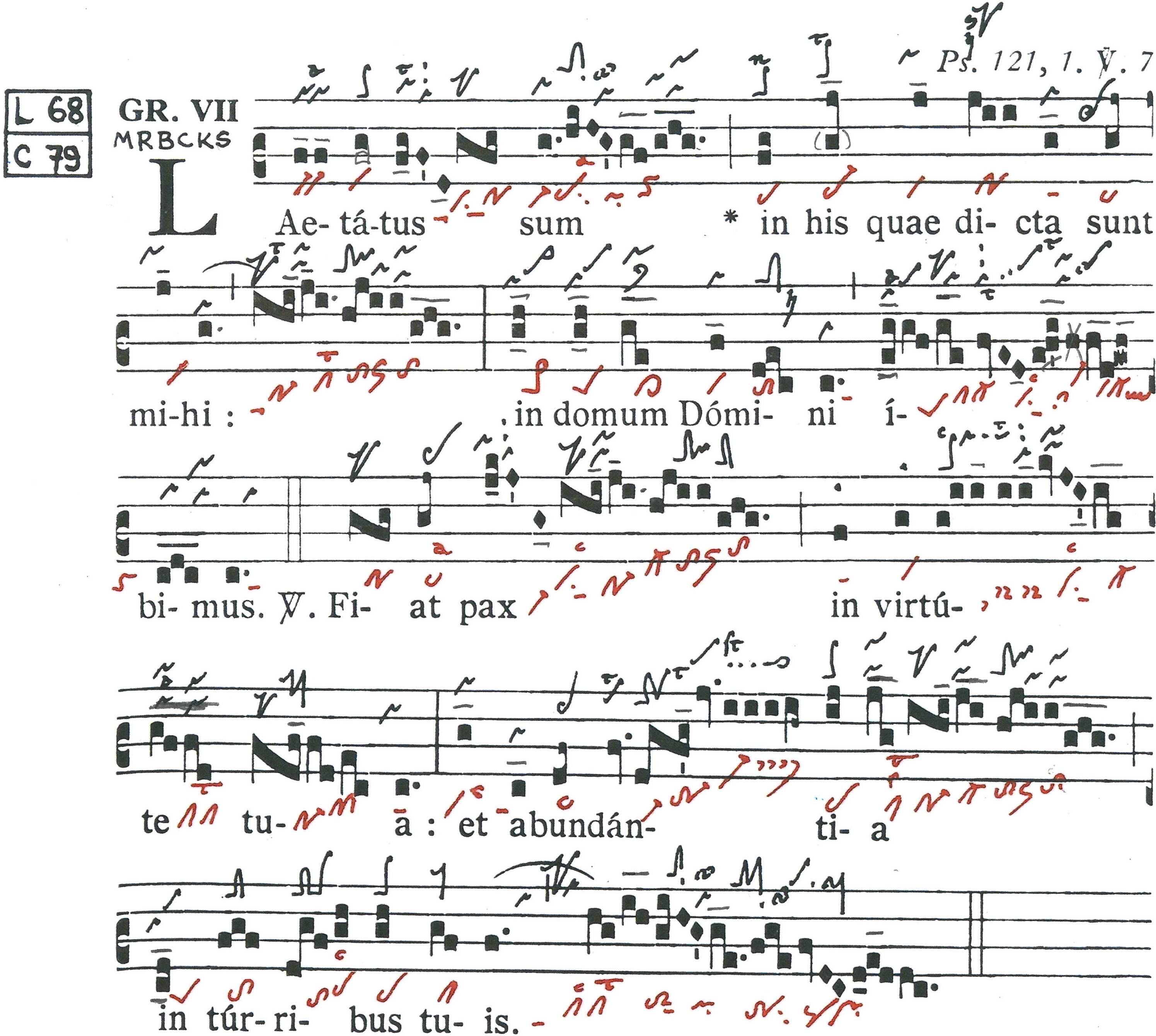
The exact same thing cleaned up: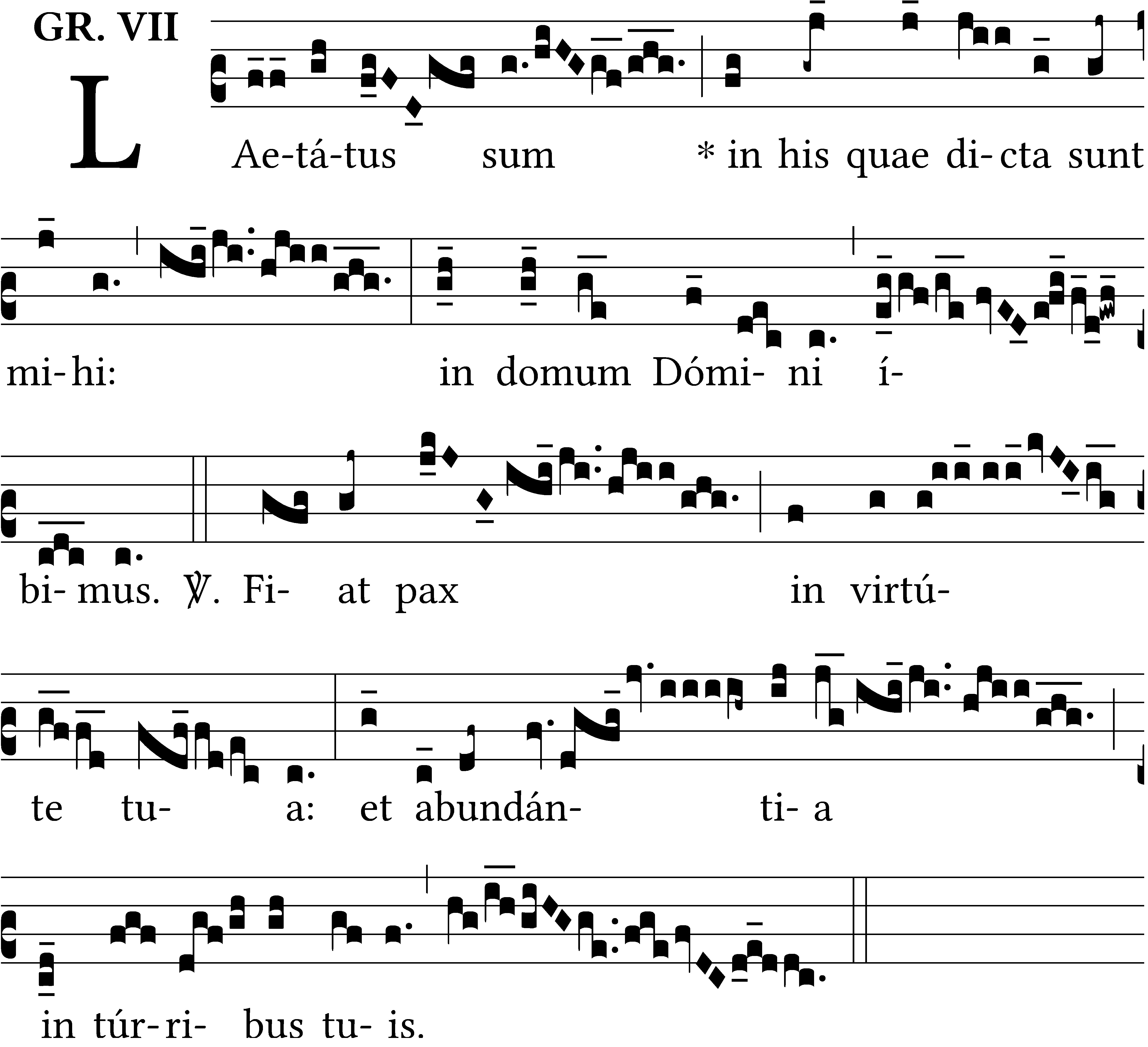
That is very literal. Applying minimal interpretive principles and revising the notation, we get this: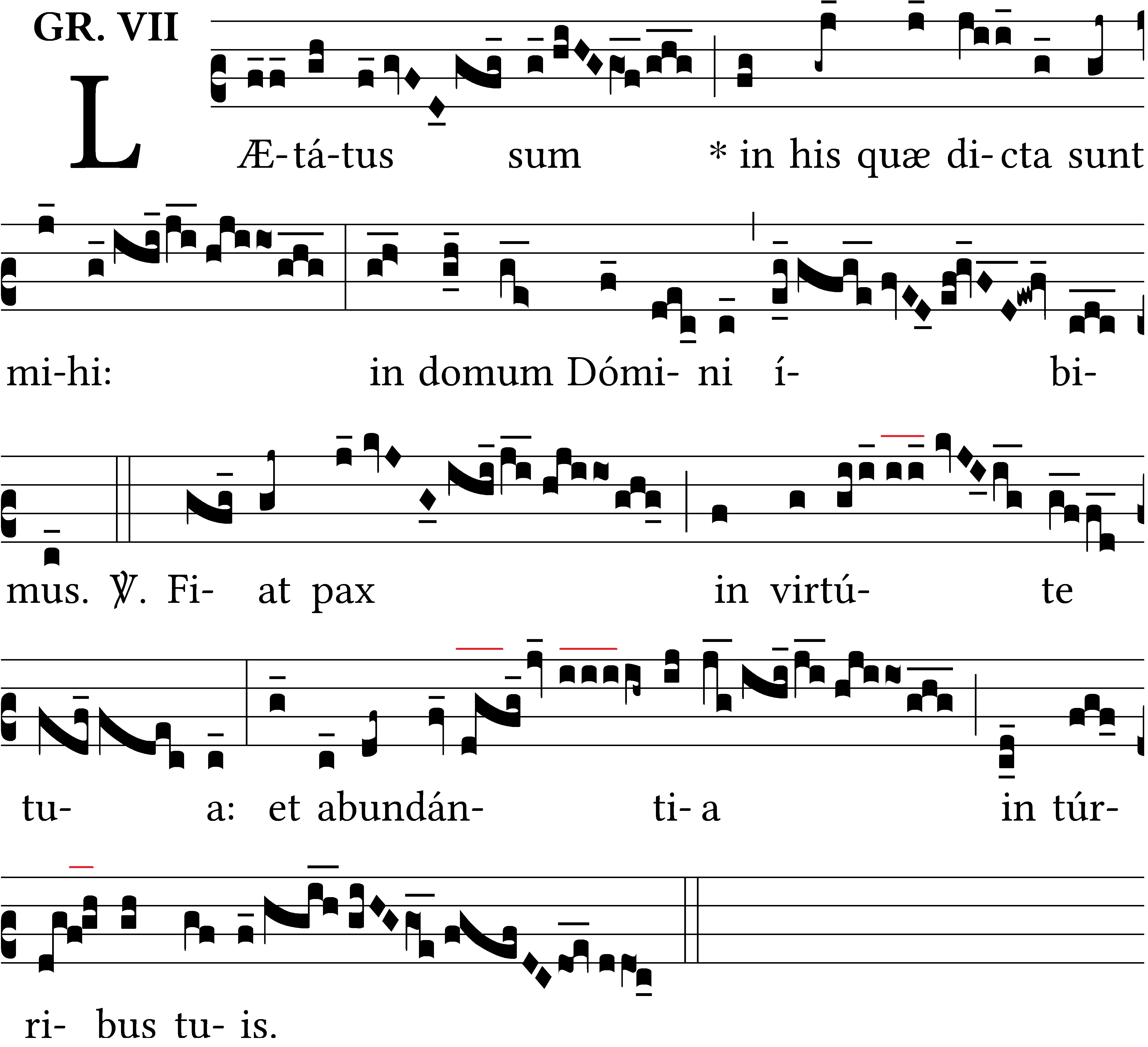
I have added a red line over the four ternary groupings. Look closely at what the manuscripts show there: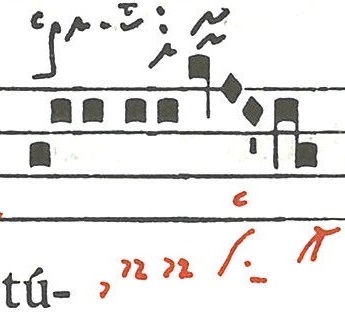
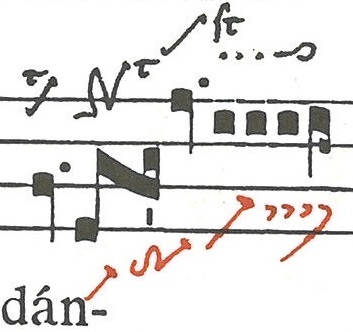

My solution:
Another possibility:
The question remains as to whether to standardize the cadential figure and, if so, how?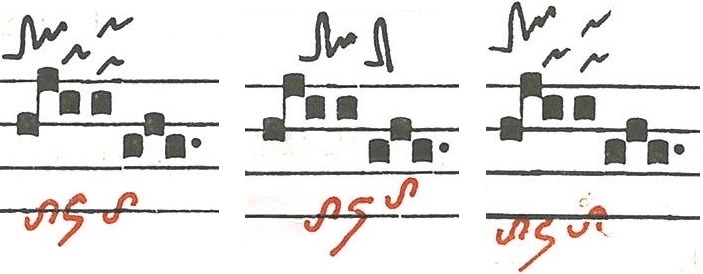
There is nothing to prevent figures such as these from being notated with the Laon neumes, which leads me to think that notes 3 and 4 should be interpreted as long: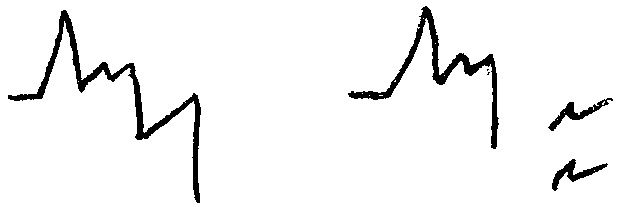
That inclines me toward option 3 below, but I left the literal reading above.
Andrew, how would your youth choir do if you were to give them mensural notation in partbook format? It's precise, historical, and attractive, and we have facsimiles readily available for lots of Renaissance polyphony, yet there are various things preventing most of us from using it.Thanked by 1CHGiffen -
@FSSPmusic
Great explanation of your process.
What do the squiggly-ish modern neumes mean? (example being 4th to last neume on the last syllable of "mihi") -
PS - The missing note at ibimus is a copyist's error in the Triplex. I went with a literal reading of the Laon neumes as reproduced in the Graduale Triplex, which was the question asked.
-
The wavy note is an oriscus.
-
I believe, using the Laon neumes, a schola would be able to chant with a consistent rhythm using the most up-to-date mensuralist interpretation of this manuscript family.
You didn’t really respond to Andrew’s point, and Patrick’s example is illuminating. You could sing from the Laon neumes, but there are reasons to produce your own edition with or without (penciling in or using nabc) the Laon neumes.
As Patrick said, and I reiterate: there is a gap, and if such a tradition did exist, there is no notice of it, not even by monks and canons recording the recollections of their elder confrères.
We also have to remember that the Greek theory does not fit perfectly onto the Western repertoire as it existed in the Carolingian period… so I don’t see how we can assume that the deviation only happened post-1000.
And just like language, there’s no reason to assume, not without more evidence, that all features of a conservative dialect are equally conservative and that borrowings only went one way; indeed, minority languages in an empire are a good analogy for possible relationships (and I emphasize possible) between Byzantine or Syriac music and Islamic practice under Islamic rule. -
@MatthewRoth
Ah, I believe there is a misunderstanding here. I didn't mean that we could literally use the Laon manuscripts. I meant that we could use them to somewhat consistently derive modern forms of mensuralist notations from them.
Of course, having lost the exact oral tradition attached to the notation, there will be specific places here and there where our understanding of the notated chants in the manuscript may be lacking, and therefore one will have to choose between two or more possible interpretations, as was the case with Patrick's example (as you yourself mentioned).
I'm sorry about not really responding to specific points here and there. I feel like some of them are not really relevant to the ideas I am trying to bounce off you guys (i.e. iron sharpens iron).
Regarding your push back to my pushback to your pushback ( that's a mouthful! ), I suppose you are right about there being silence about such a tradition. I would be interested in reading writings about Byzantine chant from Byzantine musicians from that time, to see what the discussion of such traditions sounds like in their native context. I would also be interested to read about the differences between the Carolingian music theory and Greek music theory. I thought I read somewhere that Carolingians did do a bit of borrowing from Greek music theory, but perhaps I'm wrong.
Either way, I think it would still be interesting to hear some Gregorian chant sung in proportional rhythm with some stylistic inspiration from Eastern Chant. It's purely a personal taste though.
Hopefully I have not come off as too argumentative or abrasive; I simply have the tendency to take on the role of "devil's advocate" when discussing ideas.
I greatly appreciate the activity in this thread. -
For examples of byzantinized Gregorian chant, check out Damien Poisblaud's recordings with Les Chantres du Thoronet—interesting to listen to, but it takes an awful lot of conjecture to get there:
https://www.youtube.com/watch?v=Pia_bJZdJOE -
The problem of Greek theory, particularly for chant, is that the organizational patterns of church music were borrowed and placed on an existing repertoire. I recommend basically anything on modes on the channel Early Music Sources if you don’t mind Youtube.
Of course there are universal themes (or supposedly so) derived from the classical Greeks that one can find well into the Middle Ages; educated persons would have read Boethius’s treatise on music for example. -
@FSSPmusic Thanks for the link!
It that does take a lot of conjecture. This seems to even take more liberties with ornamentation than the "Icons of Sound" performance that I linked earlier in this thread. -
For a good book on Greek musical theory and Boethius's De Musica's (and other's) influence on mediaeval European music and its theory look into getting a copy of The Critical Nexus by Charles Atkinson (Oxford, 2009). Atkinson is Professor Emeritus of Musicology at Ohio State University and has been (2007-2008) President of the American Musicological Society. A very eye-opening book about our ritual chant's origins....Boethius's treatise... -
You may be interested to hear what "semiologists" do with the gradual I dissected above.
1. Turco: https://www.youtube.com/watch?v=vmowry6eUtA
2. Schweitzer: https://www.youtube.com/watch?v=O4QA0TawkKg
Both are strict enough with the rhythm that the relative long and short values are apparent and one could even transcribe the adiastematic neumes accurately from the recording, but they are free enough that the 2:1 proportion is inconsistent, in domum serving as an example of agogic nuances where it would be perfectly sensible to sing six equally long notes.
Welcome to the MusicaSacra Forum!
To participate in the discussions on Catholic church music, sign in or register as a forum member, The forum is a project of the Church Music Association of America.
Categories
- All Discussions21,164
- General Music Discussion8,241
- Job Openings204
- Management of Music Programs850
- Choral Matters533
- Church Documents and Rubrics526
- CMAA Notes304
- Events720
- For Newcomers: Read First26
- Sacred Polyphony547
- Hymnody872
- Gregorian Chant: General2,703
- ↳ Graduale Romanum and Liber Usualis369
- ↳ Graduale Simplex60
- ↳ Semiology63
- Vernacular Plainsong696
- Anglican Use and Anglican Chant68
- Organ, Other Instruments and Repertoire435
- New Composition/Works in Progress1,295
- Recordings234
- Music for Hispanic Ministry159
- Music Education: Children211
- Music Education: General222
- News Items245
- Positions Wanted2
- General Discussion: Catholicism740
- Amusements177
- General Discussion1,035
- Opinions119
